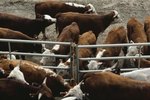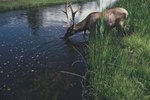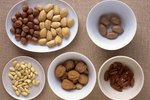
Mustangs are free-roaming horses of the American and Canadian deserts and plains. These animals aren't truly wild; they're considered feral -- they are descendants of tame horses. Some of their ancestors escaped from the Spanish invaders of Latin America in the 1500s, others were abandoned or escaped horses who joined wild herds over the following 600 years. In the wild, mustangs eat the same types of plants that native species rely on.
Grasses
The food of choice for all horses is grass. Perennial grasses are the primary food source for mustangs. Both desert and plains rangelands offer a variety of these grasses. The most common North American ones are the bunchgrasses bluebunch wheatgrass, galleta, muhly or deergrass, Indian ricegrass and Great Basin wild rye. These grasses exist in healthy, well-maintained rangeland. Mustangs also eat introduced invasive grasses such as Bermuda grass and fescue, which are more common near human habitations and disturbed pastureland. Overgrazing by range cattle and feral horses encourages the spread of invasive introduced grasses, so these grasses are becoming more common on wild rangeland over time.
Forbs
Forbs are flowering, herbaceous broadleaf plants -- in other words, almost anything that isn't a grass, shrub or tree. You may know them as weeds. Mustangs graze on forbs the same way they graze on grass; however, forbs are typically far less available in their habitat. A few, such as evening primrose, globe mallow, echinacea and certain sunflower and thistle species, are fairly common on rangelands. Other common forage forbs include all members of the introduced dandelion and clover families.
Browse
Grazing means feeding on grasses and forbs. Browsing means feeding on trees and shrubs. Zoologists consider horses mixed feeder grazer-browsers, which means they can reach up for food as well as down. Mustangs eat tree branches and shrubs when they're available. Mustang browse includes broadleaf trees such as aspen, maple, willow or apple; evergreens including juniper and pinyon; and shrubs and brush including yucca and Joshua tree, sage, salt and bitterbrush.
Soil and Licks
Mustangs have the peculiar habit of eating soil. Like most herbivores, these horses frequent mineral and salt licks, areas of exposed soil where nutrient concentrations are particularly high and the dirt has a salty flavor. In addition to licking these areas, however, mustangs have been observed to actually eat fairly substantial quantities of soil. Zoologists and veterinarians believe they do this to ingest necessary nutrients, including potassium, sodium, calcium and magnesium, which are present in the soil but lacking in their range diets.
References
- U.S. Bureau of Land Management: Rangeland Health
- Humane Society Wildlife Land Trust: Mustang - America's Wild Horses
- Digital Desert: Wild Horse (Feral Horse)
- Montana State University Extension: Packhorse Grazing Behavior and Immediate Impact on a Timberline Meadow
- The Permaculture Research Institute: Grazing and Browsing? Forage Trees and Shrubs for Horses
- College of Veterinary Medicine at Washington State University: Determinants of Mineral Lick Utilization by Feral Horses
Resources
Photo Credits
-
Comstock/Comstock/Getty Images
Writer Bio
Angela Libal began writing professionally in 2005. She has published several books, specializing in zoology and animal husbandry. Libal holds a degree in behavioral science: animal science from Moorpark College, a Bachelor of Arts from Sarah Lawrence College and is a graduate student in cryptozoology.




